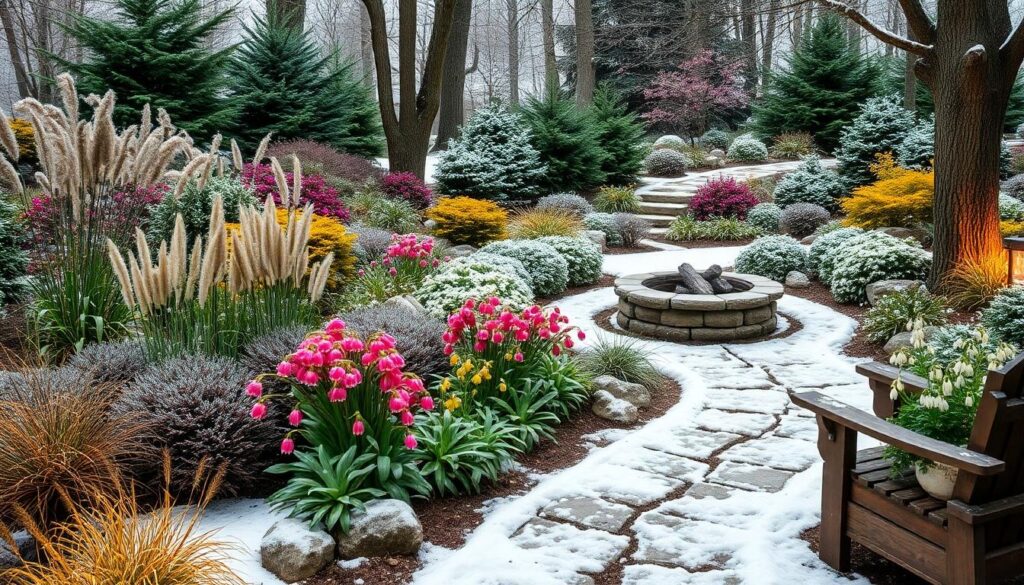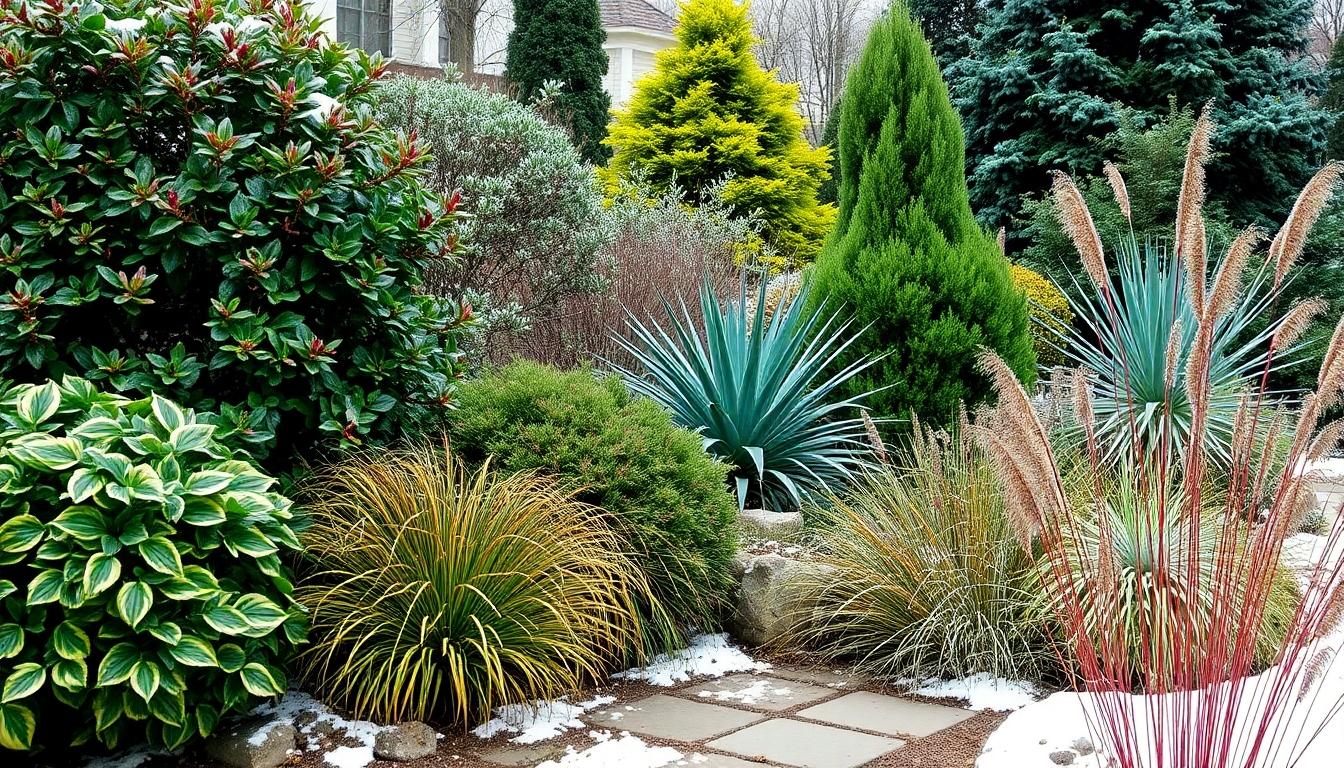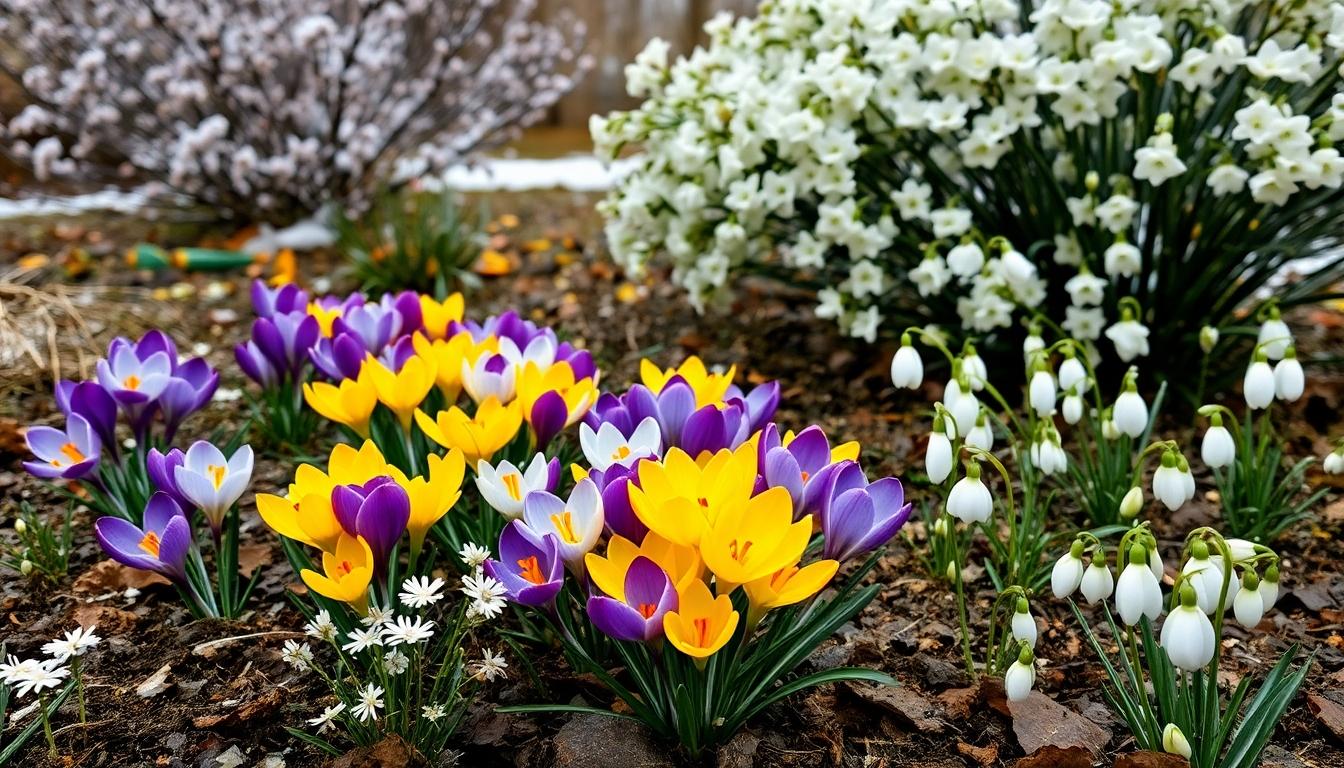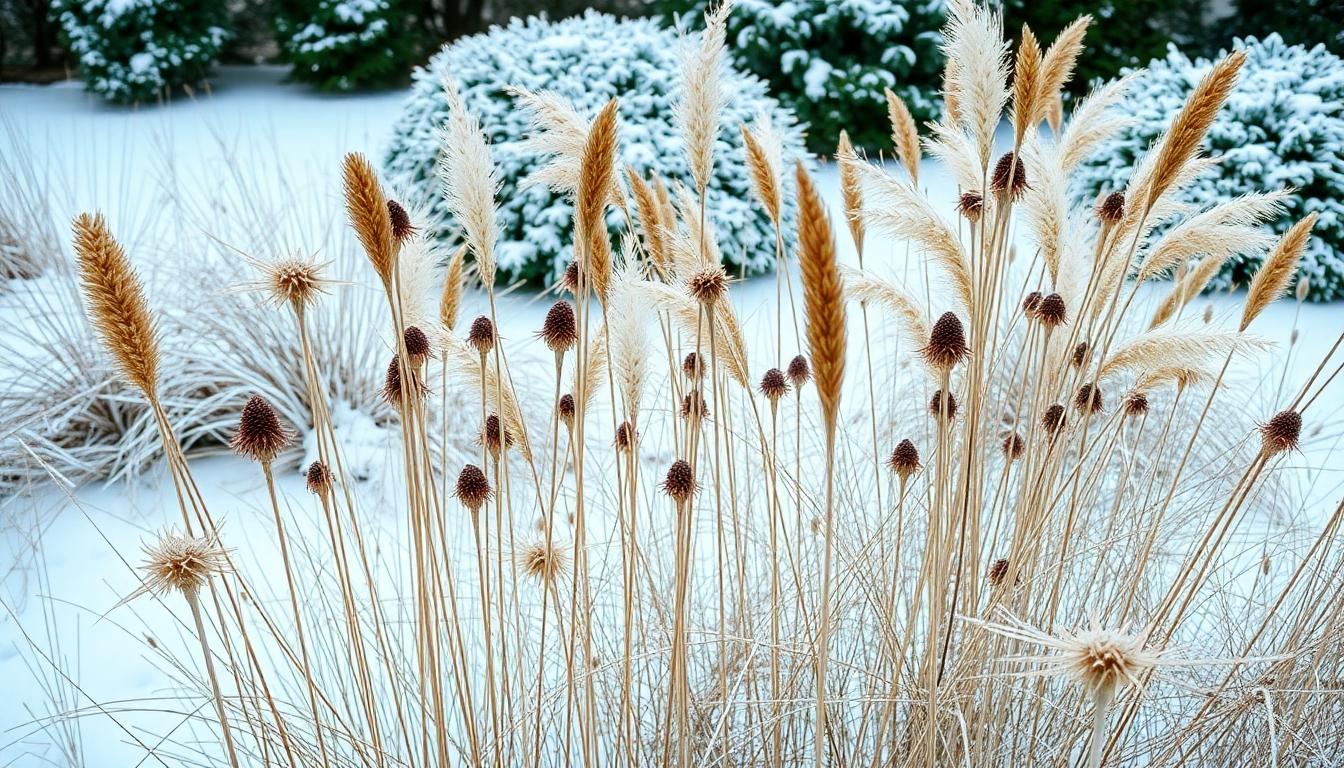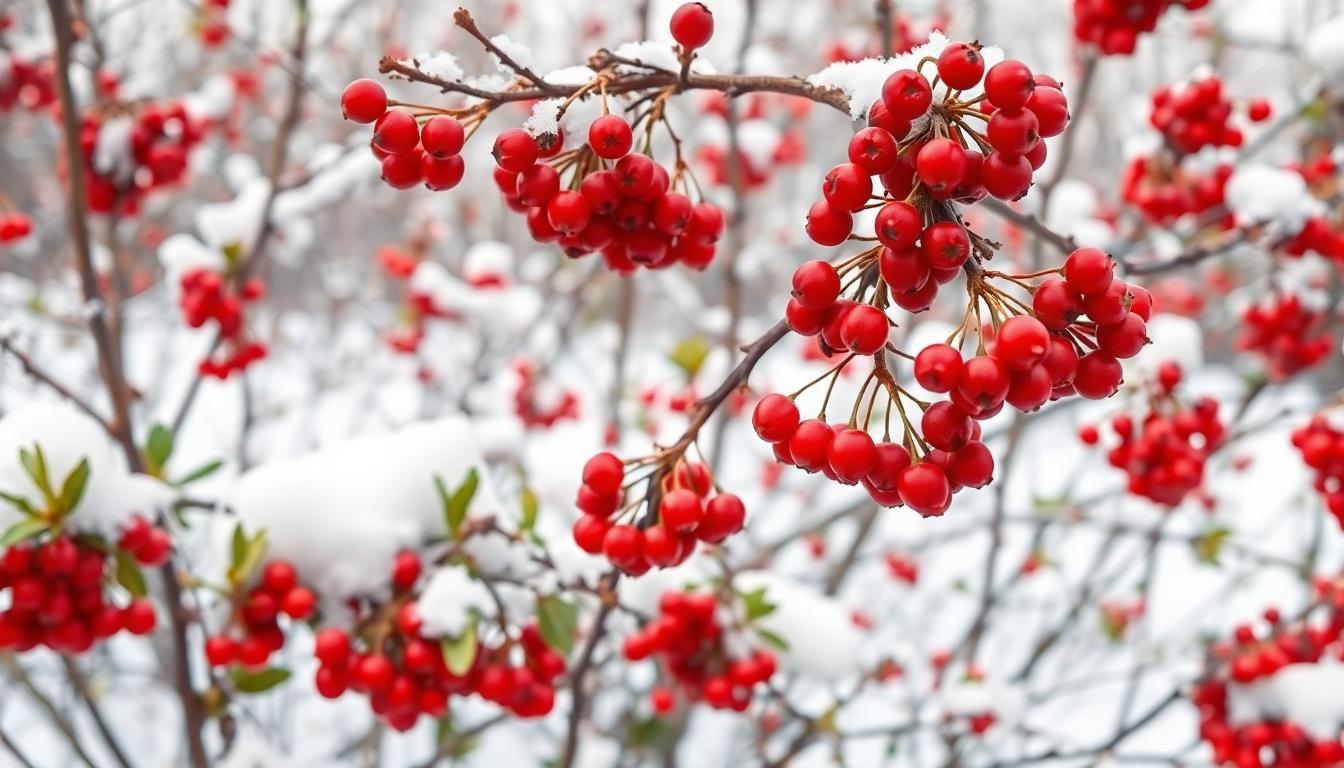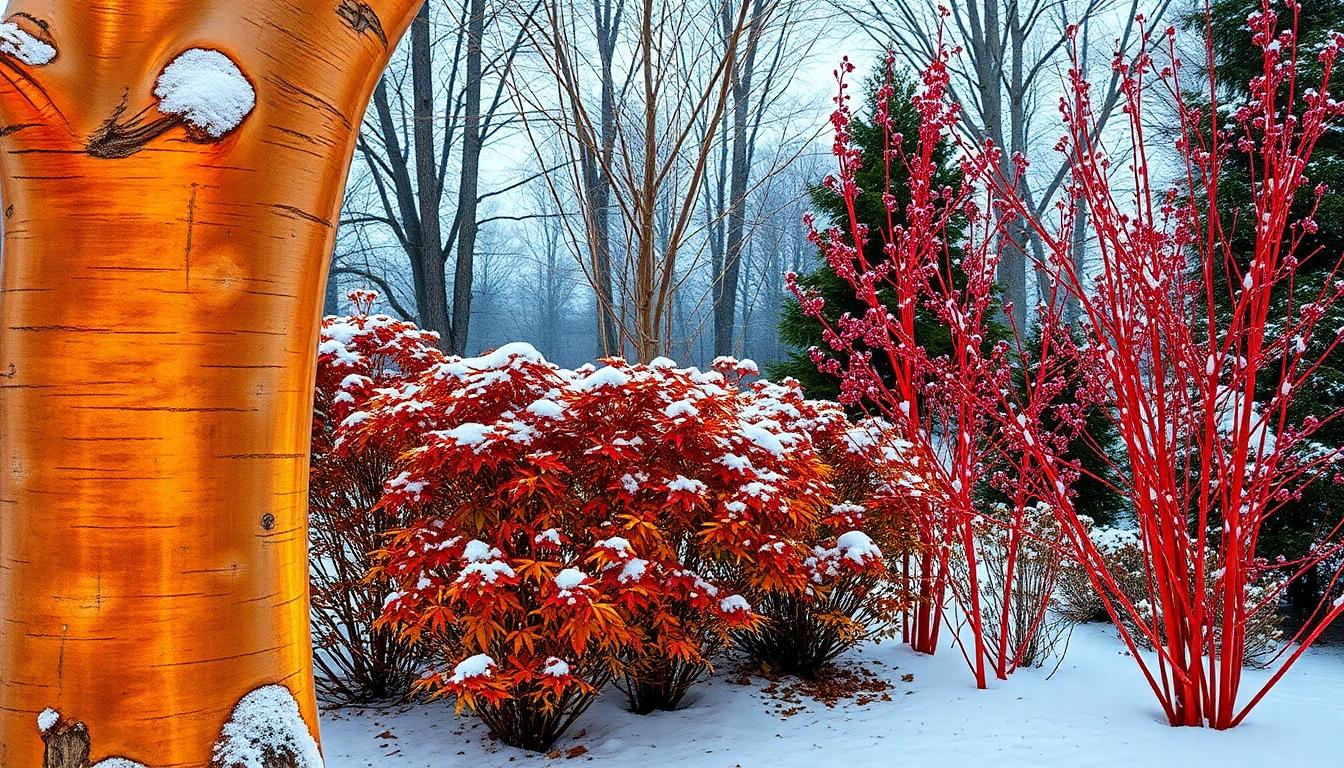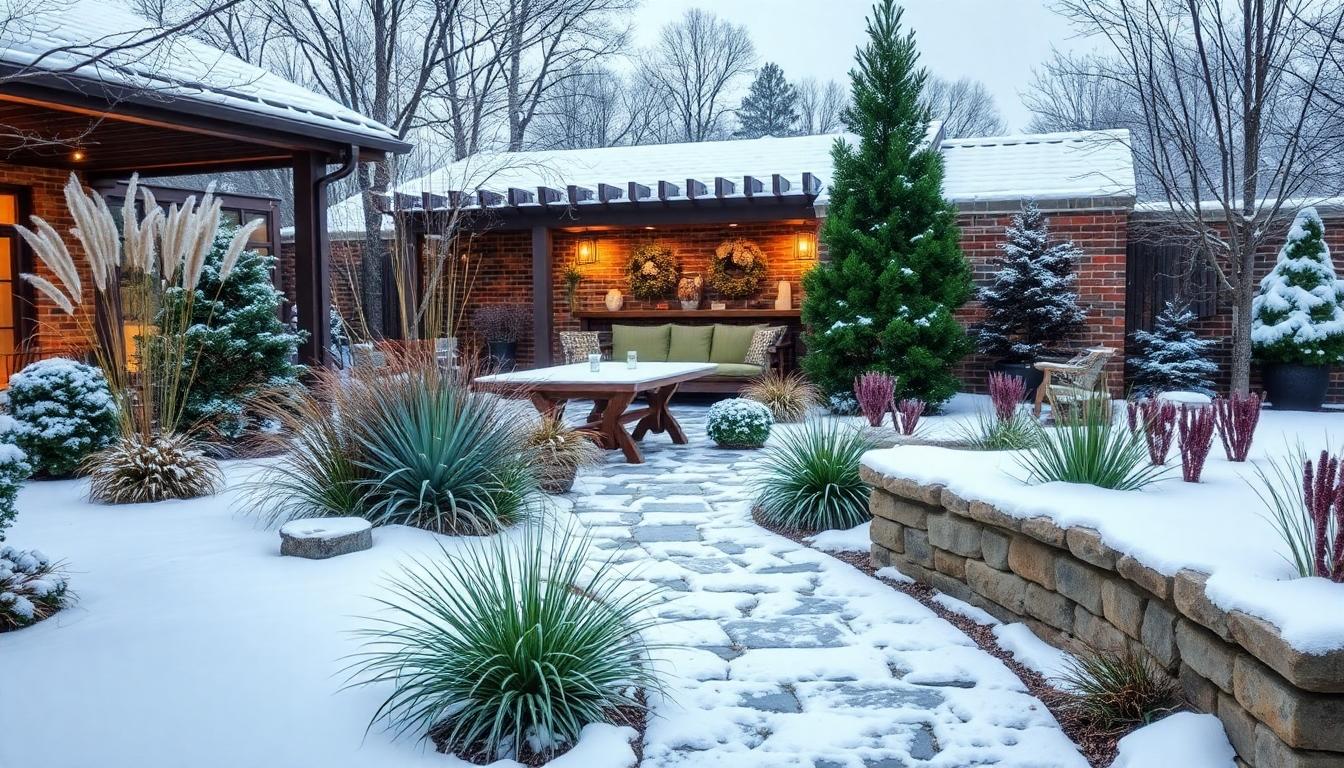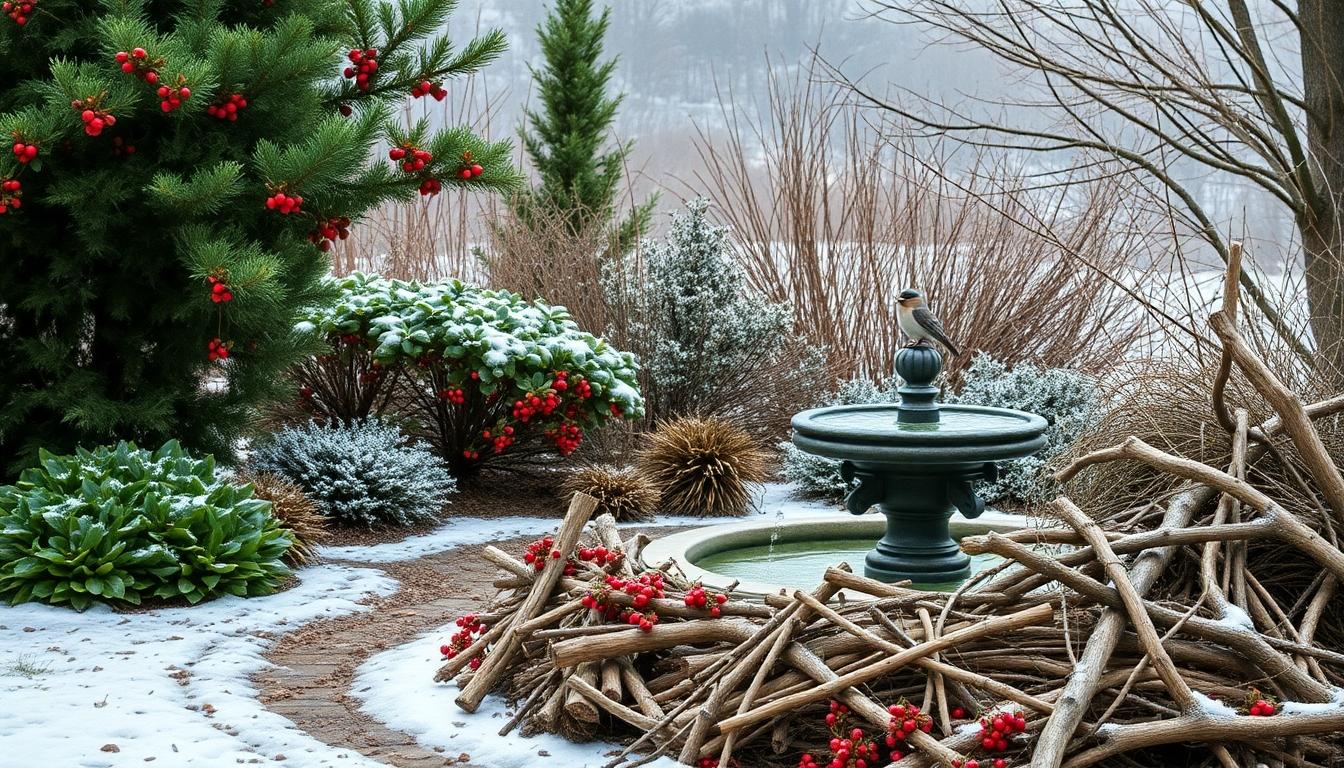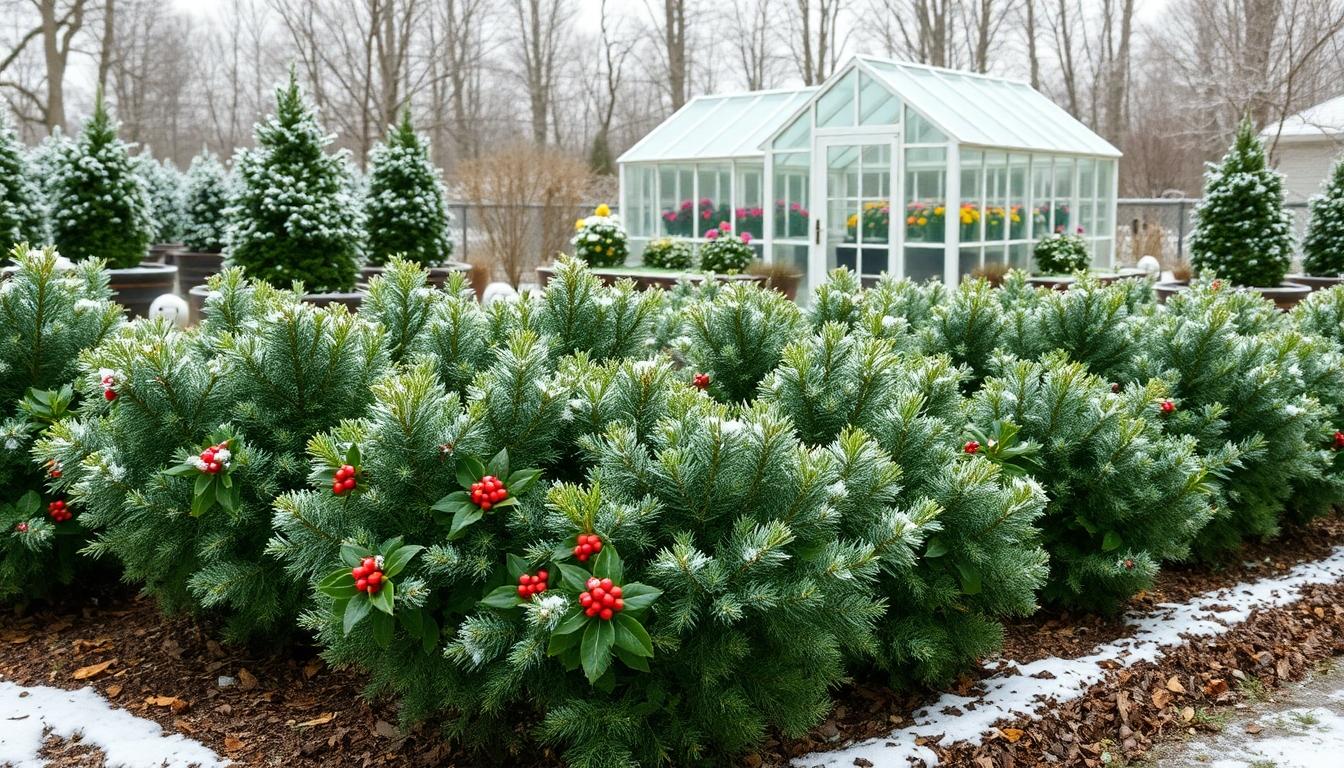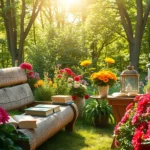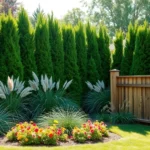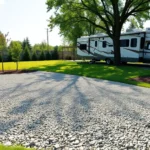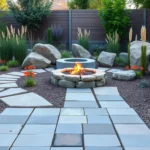Don’t let winter’s chill freeze your gardening passion! Even as temperatures drop, we’ve discovered many ways to keep your outdoor space vibrant and productive during the coldest months of the year. Winter gardens offer unique opportunities to grow certain vegetables, create stunning visual displays, and prepare for a spectacular spring comeback.
We’ll share our top winter garden ideas that transform the frosty season from a gardening pause into a period of creative cultivation. From cold-hardy plants that thrive in lower temperatures to indoor techniques that bring gardening warmth inside, these strategies will help maintain your green thumb year-round. Whether you’re a seasoned gardener or just starting out, these winter approaches will keep your gardening spirits high as the thermometer drops low.
10 Beautiful Winter Garden Ideas to Embrace the Colder Months
1. Plant Winter-Blooming Flowers
Winter gardens don’t have to be barren landscapes devoid of color. We recommend planting winter bloomers like hellebores, winter jasmine, and snowdrops to add vibrant pops of color to your garden. These resilient plants thrive in cold weather and provide a refreshing contrast against snowy backdrops. Many winter-blooming varieties also offer sweet fragrances that can transform your outdoor space into a sensory delight even on the coldest days.
2. Create Structural Interest with Evergreens
Evergreen plants form the backbone of any successful winter garden design. Their consistent foliage provides year-round structure and visual interest when deciduous plants have shed their leaves. Consider incorporating different varieties of pine, spruce, boxwood, and holly to create depth and texture. Varying heights and shapes of evergreens can establish distinctive garden “rooms” that maintain their appeal throughout the winter months.
3. Showcase Ornamental Grasses
Ornamental grasses add movement and sound to winter gardens as they sway in the breeze. Tall varieties like miscanthus, pampas grass, and fountain grass develop beautiful seed heads that catch frost and snow, creating stunning natural sculptures. Their neutral colors complement the winter palette perfectly while providing food and shelter for birds and other wildlife visiting your garden during colder months.
4. Highlight Interesting Bark and Stems
Winter reveals the hidden beauty of deciduous trees and shrubs with interesting bark patterns and colorful stems. Red-twig dogwoods display vibrant scarlet branches that stand out dramatically against snow. Plants like paper birch, river birch, and Japanese maple showcase fascinating bark textures and colors. Strategic placement of these specimens near pathways or viewpoints from windows allows you to appreciate their unique winter characteristics.
5. Install Winter-Friendly Garden Lighting
Garden lighting transforms winter landscapes after dark and extends your enjoyment of outdoor spaces. Solar path lights, string lights draped through trees, or strategically placed spotlights can highlight your garden’s best winter features. Illuminating areas with interesting shadows, frost patterns, or architectural elements creates magical nighttime scenes unique to the winter season.
6. Incorporate Bird-Friendly Features
Birds bring life and movement to winter gardens while helping with pest control. Installing bird feeders, baths, and houses not only supports local wildlife but creates endless entertainment as you observe different species visiting your garden. Position these features where they’re visible from indoor living spaces, allowing you to enjoy birdwatching even during inclement weather.
7. Design with Winter Containers
Container gardening offers flexibility for winter displays regardless of garden size. Frost-resistant pots filled with dwarf conifers, colorful heucheras, winter pansies, and trailing ivy create eye-catching arrangements for patios, entryways, and balconies. Containers can be repositioned as needed to maximize visual impact or protect plants from harsh conditions during severe weather events.
8. Build a Winter Fire Pit Area
Fire pits extend outdoor living opportunities throughout winter months, creating a cozy gathering spot for friends and family. Surrounding your fire pit with cold-hardy plants like winterberry holly, witch hazel, and ornamental cabbages enhances the winter garden experience. This combination of warmth and plant beauty makes your garden functional and inviting even during the coldest part of the year.
9. Add Sculptural Elements and Garden Art
Artistic elements take center stage in winter gardens when plants recede. Weather-resistant sculptures, decorative obelisks, or architectural salvage pieces provide focal points that stand out against the simplified winter industry. These elements cast interesting shadows on snowy surfaces and maintain visual interest when flowering plants are dormant.
10. Embrace Natural Frost Patterns
Frost transforms ordinary garden features into extraordinary displays of natural art. Plants with large seed heads like sedums, echinaceas, and alliums capture frost in captivating patterns. Ornamental features like metal trellises, stone walls, and decorative gates collect frost in unique ways. Rather than cutting back all perennials in fall, leaving some structural seed heads intact allows these frost displays to enhance your winter garden’s beauty naturally.
Creating Structure with Evergreen Shrubs and Trees
Evergreens serve as the backbone of winter gardens, providing essential structure and visual interest when deciduous plants have shed their leaves. We can strategically use these year-round performers to create a garden that shines even in the coldest months.
Best Evergreen Varieties for Winter Interest
When selecting evergreens for your winter garden, consider varieties that offer more than just green foliage. Osmanthus heterophyllus features eye-catching variegated leaves that brighten dreary winter days. Chamaecyparis cultivars deliver stunning gold or blue hues that stand out beautifully against snowy backdrops. Textural elements are equally important in winter landscapes – Parry’s agave (Agave parryi) contributes dramatic sculptural forms that catch frost in captivating ways. Ornamental grasses like feather reed grass (Calamagrostis) add movement and sound as winter breezes pass through their dried plumes. Bark and stem features provide another dimension of interest – paperbark maple (Acer griseum) showcases exfoliating cinnamon bark that peels in thin layers, while red-twig dogwood (Cornus sericea) produces vibrant red stems that appear even more striking against snow.
Strategic Placement for Maximum Visual Impact
Positioning your evergreens thoughtfully enhances their winter appeal significantly. Create focal points by placing specimen evergreens such as upright junipers near entryways or seating areas where they’ll be frequently seen and appreciated. Take advantage of winter’s low-angle sunlight by positioning plants with reflective bark (like birch) or glossy leaves (such as magnolia) where the light will highlight their unique textures. Dense evergreens like arborvitae (Thuja) can serve as effective windbreaks, protecting more tender plants while creating beneficial microclimates in your garden. Design composite arrangements by pairing evergreens with perennials like sedum or echinacea, whose seed heads provide visual interest long after their blooms have faded. Hardscaping elements including stone paths and benches complement evergreen plantings, while strategic lighting can emphasize silhouettes and extend your garden’s visual appeal well into the evening hours.
Incorporating Winter-Flowering Plants for Seasonal Color
Winter doesn’t have to mean a dull, colorless garden. We can transform our outdoor spaces with carefully selected winter-flowering plants that bring vibrant hues to the coldest months. Several resilient blooms actually prefer the chill of winter to showcase their beauty.
Early-Blooming Bulbs That Thrive in Cold Weather
Early-blooming bulbs serve as nature’s first sign that spring is approaching, often pushing through frost or even snow. Crocus bulbs deliver striking bursts of purple, yellow, and white even when the industry remains largely dormant. Snowdrops stand out as true champions of winter, producing delicate white bell-shaped flowers that often emerge while snow still covers the ground. Winter-flowering tulip varieties offer unexpected color in late winter, creating visual interest when most gardens remain barren. These cold-hardy bulbs require minimal maintenance once established and return year after year with increasing vigor. Planting these bulbs in clusters maximizes their visual impact, creating natural-looking drifts of color throughout the garden.
Shrubs That Flower During Winter Months
Winter-flowering shrubs form the backbone of any successful cold-season garden, providing structure and unexpected blooms. Winter-flowering viburnum produces clusters of fragrant flowers that perfume the air during the coldest months. Christmas Box (Sarcococca) delivers tiny but intensely fragrant white or pink blooms that can scent an entire garden area. Winter-flowering honeysuckle offers sweet-scented white or yellow flowers that brighten dark winter days while providing early nectar for pollinators. These shrubs thrive in various light conditions, making them versatile additions to any garden space. Heather and hellebores (also known as Christmas roses) round out a winter garden with their long-lasting blooms that often persist from winter into early spring. Strategic placement near walkways or windows maximizes enjoyment of these winter performers, allowing their colors and fragrances to be appreciated during the season’s limited outdoor time.
Adding Texture with Ornamental Grasses and Seed Heads
Ornamental grasses and seed heads bring movement, dimension, and tactile interest to winter gardens when other plants have gone dormant. These botanical elements transform what might otherwise be a barren industry into a ever-changing outdoor space filled with subtle beauty and ecological value.
Leaving Perennials Intact for Winter Appeal
Preserving perennials through winter offers multiple benefits beyond just visual interest. Uncut plants like sedums, coneflowers, and astilbes create organic architectural forms that stand proudly against winter backdrops. Their dried foliage and seed heads contribute fascinating textures that contrast beautifully with evergreen elements in your garden. Wildlife benefits tremendously from this practice, as these intact plants provide crucial shelter and food sources during harsh months. Birds particularly appreciate the seed heads of echinacea and other flowering perennials, creating a lively atmosphere even in the coldest weather. The layered textures of these standing perennials also capture frost and snow in captivating ways, transforming your garden into a winter wonderland after each weather event.
Grasses That Maintain Structure Through Snow and Frost
Cold-hardy ornamental grasses stand as reliable vertical elements that maintain their presence throughout winter’s challenges. Feather reed grass (Calamagrostis acutiflora) remains impressively upright even under snow loads, creating strong architectural lines in USDA zones 4-9. Switchgrass (Panicum virgatum) varieties offer similar structural integrity while adding a feathery, delicate appearance that catches morning frost in stunning displays. Miscanthus and Pennisetum species provide dramatic plumes that dance in winter winds, adding movement to static winter landscapes. These resilient grasses require minimal maintenance while delivering maximum visual impact when paired strategically with evergreen shrubs. Their presence adds depth and interest to your garden, especially when backlit by low winter sun angles that illuminate their distinctive forms.
Designing with Colorful Berries and Fruits
When winter strips away leaves and flowers, berries and fruits become stars of the garden, adding vibrant splashes of color against bare branches and snow. These natural ornaments transform dreary winter landscapes into captivating seasonal displays while supporting local wildlife.
Berry-Producing Plants for Winter Wildlife
Winter berries serve as critical food sources for birds during the coldest months due to their high sugar and fat content. Winterberry (Ilex verticillata) stands out as an exceptional choice, offering bright red berries after leaf drop and thriving in full sun and wet soil conditions. For successful berry production, pair male and female cultivars together—popular combinations include Berry Heavy® with Mr. Poppins® to ensure proper pollination. Pernettya mucronata produces distinctive berries resembling bubblegum-pink spheres that persist throughout winter, providing sustenance for various bird species when other food sources become scarce. Viburnums, particularly the compact Cranberry Bush (Viburnum opulus ‘Compactum’), deliver red berries alongside multi-season interest, making them perfect additions to smaller garden spaces. Careful selection matters when choosing berry plants, as certain varieties of Cotoneaster may be considered invasive in some regions—always verify with local gardening guidelines before planting.
Creating Vibrant Focal Points with Berry Clusters
Berry clusters add structure and vivid color to otherwise dormant winter landscapes. Pyracantha creates dramatic visual impact with its cascading orange or red berries against stone walls or wooden fences, while simultaneously providing privacy screening benefits. Ground-level interest emerges when Cotoneaster dammeri (Bearberry) is planted along terraces or pathways, its low-growing habit offering erosion resistance on slopes or walls. Winterberry makes the strongest visual statement when planted in groups of three to five shrubs, creating concentrated patches of brilliant red that stand out against winter’s muted palette. Combining berry-producing plants with evergreen foliage, such as various holly species, emphasizes berry colors through contrast and complementary textures. Diversify your winter color scheme by incorporating plants with varying berry hues—blue berries from certain Viburnum species or white fruits from snowberry create a more complex and interesting garden composition. Most berry plants require full sun exposure for optimal fruiting, though they vary in soil preferences—Cotoneaster adapts to poor soils while Winterberry flourishes in consistently moist conditions. Strategic pruning helps maintain berry production, so avoid aggressive cutting that might remove fruiting branches and compromise your winter display.
Highlighting Attractive Bark and Stems
Winter reveals the often-overlooked architectural elements of our gardens, particularly the fascinating textures and colors of bare branches and trunks. When leaves have fallen, these features become the stars of the winter industry.
Trees and Shrubs with Distinctive Winter Bark
Trees and shrubs with ornamental bark transform winter gardens into visually striking landscapes even during the coldest months. Paperbark maple (Acer griseum) stands out with its exfoliating cinnamon-colored bark that peels in thin layers, creating remarkable textural interest. Red-twig dogwood (Cornus sericea) produces vivid crimson stems that create stunning contrast against snow or evergreen backgrounds. Various willow species (Salix) offer yellow or orange branches that glow brilliantly when backlit by winter sunlight.
Birch trees (Betula) deserve special consideration for winter gardens thanks to their distinctive white or golden peeling bark that captures attention from across the industry. Stewartia (Stewartia pseudocamellia) brings elegant mottled bark in cream and brown tones, reminiscent of puzzle pieces fitting together. Japanese kerria (Kerria japonica) maintains bright green stems throughout winter, providing unexpected color when most other plants have gone dormant.
Creating Dramatic Effects with Strategic Lighting
Strategic lighting elevates the winter garden experience by highlighting structural elements after dark. Low-voltage LED lights can dramatically emphasize the textural qualities of ornamental bark, creating stunning visual effects when positioned to cast interesting shadows. Uplighting placed beneath trees with interesting bark draws attention to their architectural silhouettes and enhances the three-dimensional quality of the winter industry.
Pathway lighting serves dual purposes by ensuring safe navigation through the garden while creating pools of illumination that add visual depth to the nighttime garden scene. Solar-powered spotlights offer flexibility and sustainability when accentuating ornamental grasses or evergreen shrubs. Combining various lighting techniques allows us to create a nighttime garden experience that showcases the unique characteristics of plants selected specifically for their winter appeal.
Installing Winter Garden Containers and Raised Beds
Winter gardening requires proper planning and equipment to withstand harsh conditions. The right containers and raised beds can make all the difference in maintaining a thriving garden during the coldest months.
Frost-Resistant Container Plants and Arrangements
When selecting containers for winter gardening, frost-resistant materials are essential for lasting durability. Terracotta, wooden, or ceramic containers with excellent drainage prevent root damage during freeze-thaw cycles. We recommend using evergreen plants like boxwoods as the foundation of your winter container displays, providing reliable structure throughout the season. Colorful stems from dogwood and willow add visual interest against snowy backdrops, creating striking vertical elements in your arrangements.
Small winter flowers such as pansies and violas introduce unexpected color patches that brighten dreary winter days. Structural elements like ornamental grasses maintain their presence even under frost, adding movement and texture to static winter scenes. Creating a layered look by combining plants of varying heights maximizes visual impact in limited container space. Themed containers, such as winter wonderland arrangements, can be enhanced with decorative elements like pinecones or snow-infused glass beads for a festive touch.
Protecting Container Gardens from Extreme Temperatures
Mulching serves as a crucial insulation technique for container gardens, protecting root systems from freezing temperatures. We always apply a 2-3 inch layer of organic mulch around container plants to maintain more stable soil temperatures during cold spells. Moving containers to sheltered locations near building foundations offers additional protection from harsh winds and extreme temperature fluctuations.
For immovable containers, breathable cloths like burlap provide effective protection against frost while still allowing air circulation. Grouping containers together creates a microclimate that helps plants withstand colder temperatures than they would individually. Raised beds benefit from similar protection strategies, with their elevated design already offering improved drainage during winter precipitation events. Cedar and recycled plastic materials for raised beds resist deterioration from moisture and temperature changes, ensuring your garden structure remains intact for multiple winter seasons.
Building Hardscape Elements for Year-Round Structure
While plants go dormant during winter, hardscaping elements continue to provide structure and visual interest in your garden. These permanent features serve as the “bones” of winter gardens, creating definition and charm even in the coldest months.
Winter-Friendly Pathways and Seating Areas
Pathways constructed from slip-resistant materials ensure your garden remains accessible throughout winter’s icy conditions. Textured flagstone and gravel offer practical answers that prevent slips while maintaining aesthetic appeal against snowy backdrops. Circular patio designs with integrated heating elements transform ordinary spaces into functional winter retreats that family and friends can enjoy year-round. Strategically placed benches or seating walls near fire features invite outdoor relaxation even during colder months, extending the usability of your garden space. Materials like warm-toned brick and natural stone not only withstand freezing temperatures but also create appealing visual contrast against snow, making your winter garden both practical and beautiful.
Decorative Elements That Shine in Snow and Frost
Weatherproof LED lighting fixtures highlight architectural plants and hardscape textures after dark, creating magical evening scenes in your winter garden. Ornamental grasses such as miscanthus and switchgrass retain their structure through winter, dramatically catching frost and snow for ever-changing visual interest when other plants have faded. Cold-hardy succulents like Agave parryi and shrubs with colorful stems such as red twig dogwood add vibrant accents against neutral winter backgrounds. Textural elements including rough-cut stone walls and smooth concrete planters establish visual rhythm in monochromatic snowy landscapes. Frost-resistant materials with proper drainage prevent cracking during freeze-thaw cycles, ensuring your hardscape elements remain beautiful for years. Pairing these permanent structures with seed-bearing perennials like coneflowers or yarrow attracts winter wildlife while maintaining architectural interest throughout the dormant season.
Planning for Wildlife in Your Winter Garden
Winter gardens offer a unique opportunity to support local wildlife during the harshest months of the year. With thoughtful planning, we can create a thriving network that provides essential resources for birds and other creatures when they need it most.
Creating Food Sources and Shelter for Birds
Birds rely heavily on garden resources during winter when natural food becomes scarce. Native berry-producing plants like holly and pyracantha offer crucial nutrition through their vibrant fruits that persist throughout the cold season. We recommend leaving seed heads intact on plants such as sunflowers and coneflowers, as these serve as natural bird feeders long after their blooms have faded.
Shelter is equally important for winter bird survival. Evergreen shrubs and trees provide excellent protection from harsh winds and freezing temperatures, serving as natural windbreaks and roosting spots. Creating brush piles from fallen branches offers small birds and other wildlife a safe haven from predators and weather extremes. These simple structures can be artfully arranged in garden corners to blend with the winter industry while providing critical wildlife habitat.
Designing Water Features That Remain Accessible in Cold Weather
Access to unfrozen water can be challenging for wildlife during winter, making this resource particularly valuable in cold months. Heated birdbaths represent an excellent solution, preventing freezing and ensuring birds can drink and bathe even in sub-freezing temperatures. We’ve found that models with thermostats are most efficient, activating only when temperatures drop below freezing.
Moving water features offer another effective approach to winter water access. Small fountains or recirculating pumps keep water in motion, significantly reducing the likelihood of complete freezing while creating attractive focal points in the winter garden. Ground-level water features provide easier access for various wildlife species, from birds to small mammals. Positioning these features near shrubs or brush piles allows animals to quickly retreat to safety after visiting, increasing the likelihood they’ll return throughout the season.
Maintaining and Protecting Sensitive Plants
In winter, your garden’s most vulnerable plants need extra attention to survive the harsh conditions. Proper maintenance techniques can make the difference between thriving plants and winter casualties. Here’s how to keep your sensitive plants protected during the cold months:
Clear Garden Debris Regularly
Removing fallen leaves and garden debris is essential for winter garden health. This simple practice prevents pests and diseases from overwintering in your garden beds. Regular cleanup also improves air circulation around plants, reducing the risk of fungal issues that thrive in damp, cluttered conditions.
Choose Winter-Hardy Varieties
Incorporating low-maintenance evergreen plants provides structure throughout winter. Holly, juniper, boxwood, and various conifers can withstand harsh winter conditions while maintaining visual interest. These plants serve as the backbone of your winter garden, offering reliable greenery when other plants have gone dormant.
Group Plants Strategically
Organizing your garden by grouping plants with similar moisture and light requirements simplifies winter care significantly. This thoughtful arrangement allows you to provide targeted protection to vulnerable plants while minimizing maintenance efforts. Plants with comparable needs can share protection methods, making your winter gardening tasks more efficient.
Winter Mulching Techniques for Plant Protection
Applying the right mulch properly is one of the most effective ways to shield plants from winter damage. Organic mulches such as bark, compost, or dry leaves create a protective layer that insulates soil and roots from temperature fluctuations. This natural blanket maintains more consistent soil temperatures, preventing the freeze-thaw cycles that often damage plant roots.
Mulching delivers multiple benefits beyond just temperature regulation. A proper mulch layer reduces weed growth, eliminates the need for winter herbicides, and maintains garden tidiness throughout the dormant season. The decomposition of organic mulch also gradually enriches your soil, preparing it for robust spring growth.
When applying winter mulch, proper technique is crucial. Spread mulch to a depth of 2-3 inches around plants, but avoid piling it against stems or trunks. Overmulching can suffocate plant roots and create a haven for rodents that might damage your plants during winter months. Pull mulch back slightly from plant bases to allow proper air circulation.
Creating Microclimates in Your Garden
Strategic structures provide essential protection for tender plants during winter. Greenhouses, cold frames, and even temporary cloches can shield vulnerable specimens from harsh winds and frost. These protective environments trap heat and block damaging winter elements, extending your growing season at both ends of the calendar.
South-facing slopes and dark-colored mulch naturally retain more heat, creating warmer microclimates within your garden. Plants positioned in these areas benefit from increased soil temperatures and quicker warming on sunny winter days. This natural temperature advantage can mean the difference between survival and loss for borderline hardy specimens.
Design elements can enhance your garden’s microclimate diversity. Small evergreens strategically placed can block prevailing winds, while creative window boxes can be designed to transition seamlessly from fall to winter displays. These thoughtful additions not only protect sensitive plants but also maintain visual interest throughout the winter months.
Embracing Winter Garden Photography and Appreciation
Winter gardens offer endless beauty that’s waiting to be discovered. From frost-covered seed heads to vivid berries against snow we’ve seen how these spaces can thrive in cold months.
By implementing the ideas we’ve shared you’ll create not just a seasonal garden but a year-round retreat that supports wildlife and lifts spirits during darker days. The subtle charms of winter landscapes often reveal themselves in morning frost geometric branch patterns and the quiet resilience of evergreens.
Remember that winter gardening isn’t about fighting the season but embracing its unique character. Your garden doesn’t hibernate – it transforms. With thoughtful planning and appreciation for winter’s distinct palette we can find joy in our gardens every day of the year.
Frequently Asked Questions
What are the best flowers that bloom in winter?
Winter-blooming flowers like hellebores, snowdrops, winter aconite, and witch hazel add surprising color to winter gardens. Early-blooming bulbs such as crocus and winter iris also thrive in cold weather. For reliable winter color, consider planting winter-flowering shrubs like viburnum and Christmas Box (Sarcococca), which offer beautiful blooms and often delightful fragrance even in freezing temperatures.
How important are evergreens in a winter garden?
Evergreens are absolutely essential in winter gardens as they provide structure, color, and visual interest when deciduous plants are dormant. They create the backbone of your winter landscape and offer screening, windbreaks, and wildlife habitat. For maximum impact, choose varieties with interesting colors or textures like blue spruce, variegated holly, or gold-tinted cypress, and place them strategically to catch low winter sunlight.
Can I grow vegetables during winter months?
Yes, you can grow vegetables in winter, especially cold-hardy varieties like kale, Brussels sprouts, leeks, and certain lettuce varieties. Using protection methods such as cold frames, row covers, or greenhouses extends your growing season significantly. Winter vegetables often taste sweeter after frost exposure due to increased sugar production. For best results, start these crops in late summer to early fall for winter harvests.
What maintenance does a garden need in winter?
Winter garden maintenance is minimal but important: clear fallen debris to prevent disease, protect sensitive plants with mulch or covers during extreme cold, prune dormant trees and shrubs (except spring bloomers), and monitor for winter pests. Check winter containers regularly for moisture, as they can dry out despite cold temperatures. These basic tasks keep your garden healthy while preparing it for vibrant spring growth.
How can I attract birds to my garden in winter?
Attract winter birds by providing food, water, and shelter. Plant native berry-producing shrubs like winterberry and beautyberry, leave seed heads on plants like coneflowers and ornamental grasses, and supplement with bird feeders offering high-energy seeds. Most critically, maintain a heated birdbath or water feature since unfrozen water is scarce in winter. Dense evergreen shrubs provide essential protective roosting sites during harsh weather.
What are the best containers for winter gardening?
Choose frost-resistant containers made of thick fiberglass, concrete, or heavy-duty plastic that won’t crack during freeze-thaw cycles. Ensure good drainage with elevated feet or platforms to prevent ice damage. Size matters—larger containers provide better insulation for plant roots. Fill with winter-interest plants like dwarf evergreens, ornamental cabbage, pansies, and colorful stems like red-twig dogwood for stunning winter displays that withstand challenging conditions.
How do I protect sensitive plants during winter?
Protect sensitive plants by applying 2-3 inches of mulch around roots after the ground freezes, wrapping vulnerable shrubs with burlap or frost cloth (not plastic), creating windbreaks with temporary structures, and moving container plants to sheltered locations. For extremely tender specimens, consider cold frames or mini-greenhouses. Avoid fertilizing late in fall, which stimulates vulnerable new growth, and ensure plants enter winter well-watered for better frost resistance.
What hardscape elements work best in winter gardens?
Effective winter hardscaping includes slip-resistant stone pathways that remain accessible after snow, structural elements like arbors and trellises that create visual interest when dusted with snow, and weatherproof seating areas positioned to catch winter sun. Incorporate outdoor lighting to illuminate garden features after early sunsets, and consider decorative elements like fire pits, sculpture, or water features designed to withstand freezing temperatures while enhancing the winter landscape.
Can ornamental grasses really enhance a winter garden?
Absolutely! Ornamental grasses transform into winter garden stars as their dried plumes and foliage create movement, catch snow, and produce beautiful silhouettes against winter skies. Varieties like miscanthus, feather reed grass, and little bluestem maintain their structure through winter storms. Their rustling sounds add sensory interest, while their neutral tones complement colorful berries and evergreens. Additionally, these grasses provide valuable habitat and food for wildlife throughout winter.
How can I create garden interest with winter lighting?
Create magical winter garden lighting by highlighting architectural elements like ornamental bark and evergreen textures with upward-facing spotlights. Install low-voltage LED path lights for safety and ambiance during early winter evenings. String weatherproof fairy lights through deciduous trees to emphasize their branching structure. Consider color-changing lights to enhance snow and ice formations. Solar options work well in sunny winter gardens, while battery or electric systems ensure consistent illumination during shorter days.

